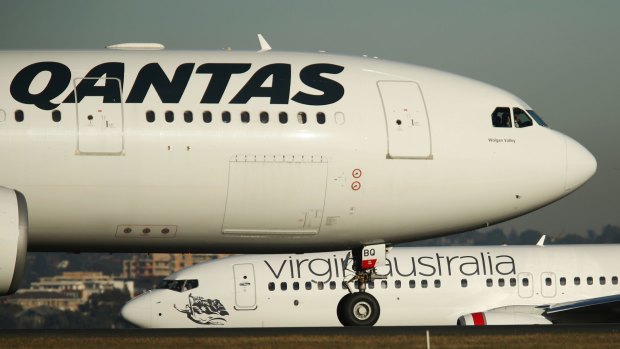This was published 7 years ago
The reasons why planes are nearly always painted white
By Soo Kim

Qantas and Virgin's planes are all white.Credit: Bloomberg
Why are planes nearly always painted white? There are exceptions. Air New Zealand once turned a Boeing 777 into a giant advert for The Lord of the Rings. Mango, based in Johannesburg, utilises a bright orange hue, while Siberian carrier S7 tends to colour its planes lime green.
But the vast majority of passenger aircraft are painted white. Why?
It keeps the plane cool
"The main reason why aircraft are painted white or light colours is to reflect sunlight and minimise both the heating and any potential damage from solar radiation," R John Hansman, professor in aeronautics and astronautics, told Business Insider.
The Concorde was 11.30 metres in height with a wing span of 25.56m. It had to be painted with a special highly reflective white paint.
Plane features made of plastic and composite materials such as carbon fibre and fibreglass need the most protection from the heat of the sun. Therefore parts such as the nose cone of the plane, where the aircraft radar is housed, and the control surfaces, which are made of composite materials, are all usually painted white or light grey, Hansman explained.
Concorde had to be painted with a special highly reflective white paint so it could withstand the heat generated from supersonic travel.
It's cheaper
Using additional colours means extra weight. "Paint adds between 273 and 544 kilograms of weight to an aircraft," a spokesperson for Boeing told Telegraph Travel. Extra weight means more fuel is burned, and 544kg equates to around eight passengers.
The paint itself costs money, too, and repainting an aircraft uses a lot of it. All told, repainting a plane costs between US$50,000 (NZ$69,297) and US$200,000. Furthermore, airlines often end up selling their aircraft to other carriers. They will find it harder to do so if the colour scheme is anything but white.
It improves visibility
Aircraft visibility could be enhanced by white or brightly coloured exteriors to increase its detection and avoidance by birds, according to research, such as a US study published in the journal Human-Wildlife Interactions in 2011.
That doesn't mean, however, that aircraft with dark exteriors are riskier to fly.
A spokeperson for the Civil Aviation Authority told Telegraph Travel: "There are no requirements from a safety point of view regarding aircraft paint schemes."
It stops tarnishing
Until just after the Second World War, most aircraft exteriors were left unpainted, or decorated with only the airline emblem. Even in recent times some airlines have avoided using paint on their aircraft.
"Those planes would start to tarnish over time, meaning airlines had to spend time and money polishing them frequently," Hansman said. "So most airlines now use light coloured paint."
But paint is more than aesthetic; it affects the weight of the aircraft and protects the integrity of the airframe, according to the US Federal Aviation Association.
"While the lighter weight of a polished plane saves fuel costs, the savings are more than offset by the higher cost of washing, polishing and painting a polished fuselage throughout its service life," says Boeing. The maintenance of polished planes is said to cost S$82,000 more per year than fully painted planes.
The Telegraph, London
Sign up for the Traveller newsletter
The latest travel news, tips and inspiration delivered to your inbox. Sign up now.